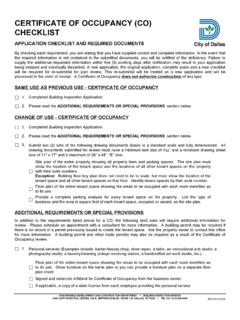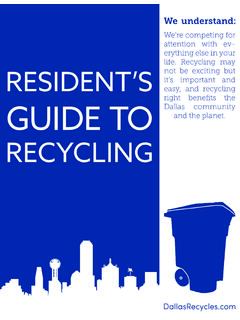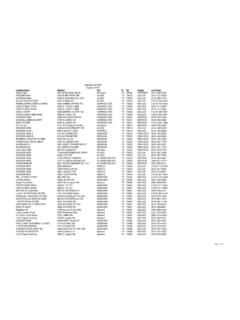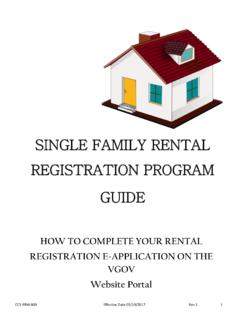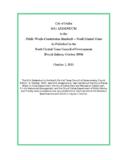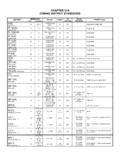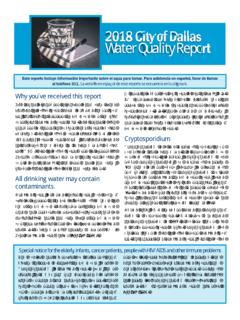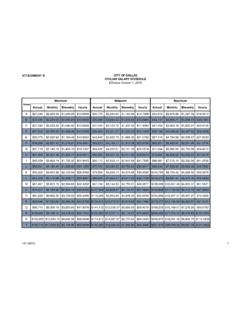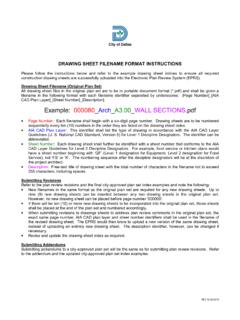Transcription of ZONING ORDINANCE ADVISORY COMMITTEE THURSDAY ... - …
1 ZONING ORDINANCE ADVISORY COMMITTEE THURSDAY , June 18, 2020. DALLAS DEVELOPMENT CODE AMENDMENT. FILE NO. DCA 190-002. Parking Current Parking Regulations Planner: Vasavi Pilla REQUEST: Consideration of amending off-street parking and loading requirements including, but not limited to, hotel, restaurant, multifamily, alcoholic beverage establishment, and public and private schools uses in the Dallas Development Code. BACKGROUND: On September 5, 2029, City Plan Commission (CPC) authorizied a public hearing to consider amending Chapters 51 and 51A of the Dallas Development Code, with consideration to be given to amending off- street parking and loading requirements including, but not limited to, hotel, restaurant, multifamily, and alcoholic beverage establishment uses, and transit -oriented development. The intent of this code amendment is to review the current parking regulations and based on research, best practices , and other cities approach to parking and their requirements, determine the need to amend the City Code and make a recommendation and proposal.
2 Staff will provide reports on the following in order to build on information, culminating with recommendations and a proposal: 1. Current Parking Regulations 2. Index Cities and Other Cities Research 3. Local and National Parking Studies 4. Feedback from Interested parties, Industry, Developers and communities and neighborhoods. RESEARCH/STAFF ANALYSIS: This report is a compilation of all current parking and loading requirements, exceptions, reductions, special parking, parking credits, and anything else parking related contained throughout the code. Current Parking Regulations The City of Dallas parking and loading regulations are generally based on land uses with options for parking reductions and credits provided. Several ZONING districts have specific parking requirements incorporated within the district regulations such as Planned Development Districts which often contain parking requirements specific to that district.
3 Appendix -1 (pages 4-9) contains a chart of the parking and loading requirements for the land uses. The Development Code also provides options for parking reductions and credits: 1. Parking Special Exceptions 2. Tree Preservation Parking Reduction 3. Administrative Parking Reduction Page 1 of 44. DCA 190-002. 4. Reduction for Providing Bicycle Parking 5. ZONING Districts with specific parking regulations contained in that district's regulations 1. PARKING SPECIAL EXCEPTIONS. Board of Adjustment (BDA) can grant reduction up to 25% of parking reduction for all uses if they have been able to prove that the special exception would not create a traffic hazard or increase traffic congestion on adjacent or nearby streets along with meeting the other criteria For the commercial amusement (inside, except for dance hall) use and the industrial (inside) use, the maximum reduction authorized by this section is 75 % or one space, whichever is greater, minus the number of parking spaces currently not provided due to delta credits.
4 2. TREE PRESERVATION PARKING REDUCTION. The number of off-street parking spaces required may be reduced by one space for each protected tree (as defined in Article X) retained that would otherwise have to be removed. 3. ADMINISTRATIVE PARKING REDUCTION: The director may grant a reduction in the number of off-street parking spaces for the following specific uses up to the % shown if the reduction would not create a traffic hazard or increase traffic congestion on adjacent or nearby streets. Factors the director must consider when determining the parking reduction: The extent to which the parking spaces provided will be assigned, compact, remote, shared, or packed parking. Parking demand and trip generation characteristics for the occupancy for which the reduction is requested. Number of employees Number of company vehicles parked on the site Whether or not the subject property or the surrounding properties are part of a modified delta overlay district.
5 Current and probable future capacities of adjacent and nearby streets based on the city's thoroughfare plan. Availability of alternative transportation modes and availability, access, and distance to public transit and the likelihood of their use. Feasibility of parking mitigation measures and the likelihood of their effectiveness. Impact on adjacent residential uses. The maximum reduction authorized by this section for specific uses is: Industrial (inside) 50 percent Industrial (outside) 50 percent Office uses and retail and personal service uses 20 percent (must not be within 600 feet of a (except for restaurants and alcoholic beverage single-family or duplex district and the use must establishments) within a 1,200 feet walking distance be connected to the rail transit station by a of a platform of a rail transit station sidewalk with a minimum width of six feet). Trade center 25 percent 50 percent (up to 75 percent if the requirement of Warehouse greater than 100,000 square feet Subsection (d)(3) is complied with).
6 Museum/art gallery 50 percent Page 2. DCA 190-002. 4. REDUCTIONS FOR PROVIDING BICYCLE PARKING. Required off-street parking may be reduced by one space for every six Class I bicycle parking spaces or for every four Class II bicycle parking spaces; A minimum of 20 off-street parking spaces required in order to receive a parking reduction of one space. A parking reduction granted above cannot exceed five percent of the total required off- street parking spaces. 5. ZONING Districts with specific parking requirements contained in that district's regulations Parking District [(A)]: A parking district creation has to go through the ZONING amendment process providing: dimension, bearing, location, meathod of ingress and egress, and other regulations as specified in Section. 51(A) Off-Street Parking in Central Business District: The regulations related to the off-street parking and commercial parking lots is specified in Section Handicap Parking Regulations: Handicapped parking must be provided and maintained in compliance with all Federal and State laws and regulations.
7 Off street stacking: The purpose of stacking space requirements is to promote public safety by reducing on-site and off-site traffic congestion. A stacking space may be located anywhere on the building site provided that it can effectively function in a manner consistent with its purpose. Sections provides the regulation related to this. Mechanized parking: provides alternatives to the standard parking and loading regulations in Division to allow parking within a structure when an approved mechanical system is used to park and retrieve vehicles Remote parking: Remote parking allows an exception to the requirement that all off-street parking be provided on the lot occupied by the main use as per the regulations listed under Sections Shared parking: Shared parking allows an exception to the requirement that no off-street parking space for one use be included in the calculation of the parking required for any other use as per the regulations listed under Section Packed parking: PACKED PARKING means off-street parking that is governed by special dimensional standards for parking spaces, allowing maximal parking on the lot when an attendant is used, as per the regulations listed under Sections Parking Management Overly District.
8 Section , Parking Management Overlay (-PM), for the regulations governing the parking management overlay. Article XIII-Form Districts Parking: Off-street parking regulation related to the uses and Mixed Use district are listed under the Section (Appendix-4, pages 35-44). Page 3. DCA 190-002. APPENDIX-1 : Parking and Loading Regulations by Use Page 4. DCA 190-002. Page 5. DCA 190-002. Page 6. DCA 190-002. Page 7. DCA 190-002. Page 8. DCA 190-002. Page 9. DCA 190-002. APPENDIX-2 : Off Street Parking Regulations SEC. OFF-STREET PARKING REGULATIONS. (a) General provisions. (1) Off-street parking is an accessory use and is subject to Section (a). (2) In any district except a central area district, the off-street parking requirements for each use are listed by use in Sections through (3) When a lot is used for a combination of uses, the off-street parking requirements are the sum of the requirements for each use, and no off-street parking space for one use is included in the calculation of off-street parking requirements for any other use, except as otherwise provided in this division or in Division (4) For purposes of determining required off-street parking, site area, as defined in Section 51A- , does not include that area occupied by off-street parking, landscaped areas, and open space not used for storage or sales.
9 ( ) For purposes of determining required off-street parking, floor area does not include the area of a building used exclusively to provide bicycle parking spaces. (5) In determining the required number of parking spaces, fractional spaces are counted to the nearest whole number, with one-half counted as an additional space. (6) No parking space located on a public street or alley may be included in the calculation of off- street parking requirements. (7) Except for residential uses, head-in parking adjacent to a public street where the maneuvering of the vehicle in parking or leaving the parking space is done on a public street is excluded in computing off-street parking requirements. (8) In all districts except a central area district, required off-street parking must be available as free parking or contract parking on other than an hourly or daily fee basis. This requirement does not apply to institutional uses or mechanized parking approved under Division (9) A parking space must be at least 20 feet from the right-of-way line adjacent to a street or alley if the space is located in enclosed structure and if the space faces upon or can be entered directly from the street or alley.
10 This provision controls over any building line platted to a lesser setback and any other provision of this article. (10) Except as specifically permitted in this article, all off-street parking must be provided on the lot occupied by the main use. (11) The board of adjustment may not authorize the placement of special parking, as defined in Division , in a residential district. (12) Off-street parking may be provided in a parking district in accordance with Section (13) In an agricultural, multifamily, MH(A), or nonresidential district, a person shall not construct or maintain a parking lot or garage that has access to a public alley or access easement that abuts or is in an R, R(A), D, D(A), TH, TH(A), or CH district unless the director approves the means of access. (14) Off-street parking is not permitted in a visibility triangle as defined in Section (b) Off-street parking provisions for residential districts.

